The RM 72-01 is a first for Richard Mille – a relaxed, playful flyback chronograph that, while remaining as interesting and eye-catching as its siblings, is quite a different mechanical beast from the others.
Technically it is a powerhouse, but the RM 72-01 does dance to a newer, more fluid beat. It is colorful without being ostentatious; sleek without having an ultra-slim case; and decidedly modern without breaking with Richard Mille’s previous design language.

Richard Mille RM 72-01 in titanium on the wrist of a dancer in ‘Within’ (photo courtesy Richard Mille/Melissa Roldan)

Richard Mille RM 72-01 flyback chronograph in red gold (left) and titanium on the wrist of dancers in ‘Within’ (photo courtesy Richard Mille/Melissa Roldan)
It is not surprising to me, then, that Richard Mille’s marketing department has paired the RM 72-01 with a pas-de-deux choreography called “Within” that was created by brand ambassador Benjamin Millepied and beautifully danced in the Joshua Tree National Park in California by two contemporary ballet dancers.
Richard Mille RM 72-01 Lifestyle In-House Chronograph: design
The RM 72-01 was holistically conceived – the case and movement going hand in hand – so no movement holder ring was necessary; the movement fits the case like a glove and is mounted on blocks secured to the case with four titanium screws.
Elegance and refinement are the name of the game with the RM 72-01 chronograph. But there is another element that becomes obvious by just looking at it – an element underscored by the modern ballet crafted to introduce it: playfulness.
Looking at the RM 72-01 for the first time, what perhaps jumps out are the Super-LumiNova-filled markers placed at 3, 8, and 11 o’clock. These play hopscotch with the trio of subdials dominating the openworked dial while continuing to reveal the skeletonized movement below.
The subdials are not positioned the same way traditional chronograph counters would be – though to be fair most modern chronographs are not housed in tonneau-shaped cases, either. Traditional is not Richard Mille’s style.
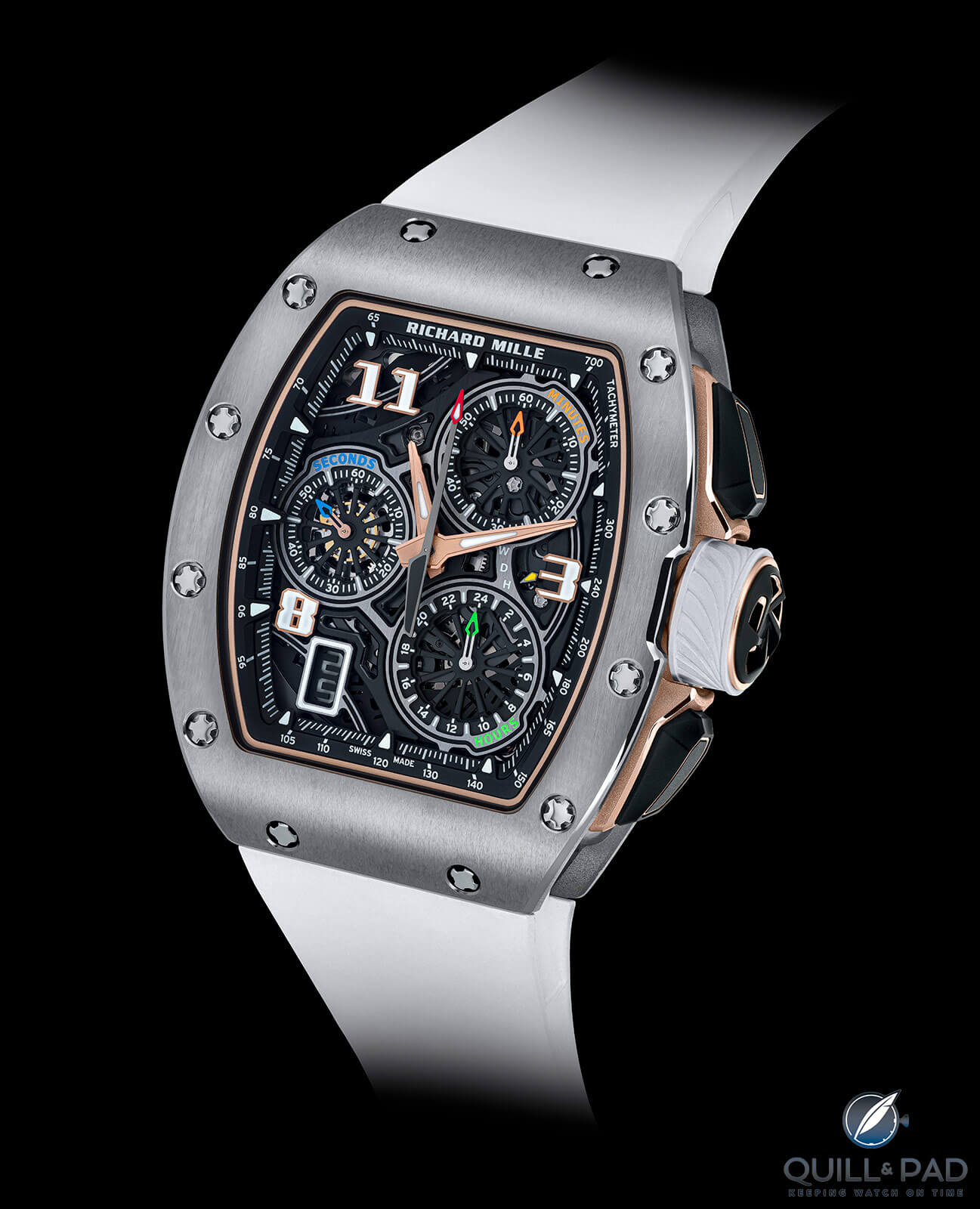
Richard Mille RM 72-01 Lifestyle In-House Chronograph in titanium
These counters at 1, 4, and 9 o’clock are different sizes and decorated with a discrete amount of bright color in the tabs sticking out from the subdials and hand tips: orange on the minute totalizer at 1 o’clock; blue on the running seconds at 9 o’clock, and green on the 24-hour totalizer between 4 and 5 o’clock.
The sweeping second hand is so unobtrusive it does not disturb the design. Yet its red-and-Super-LumiNova tip make it quite legible if you need it.
The displays are rounded out by the tachymeter scale around the tonneau-shaped flange and an unusual, rather technical-looking vertical date at 7 o’clock.
Despite all that detail, this model is sleek, comparatively pared down, and ready to give you what you need and definitely all you want.
Richard Mille in-house chronograph Caliber CRMC1
Automatic Caliber CRMC1 is the first flyback chronograph produced in-house at Richard Mille. It is based on the brand’s manufacture automatic movement. Fully designed, crafted, and assembled in Richard Mille’s Les Breuleux factory, its manufacture status is worth noting because Richard Mille has generally worked with both Vaucher and Audemars Piguet Renaud & Papi (APRP) throughout most of the brand’s 19-year lifespan.
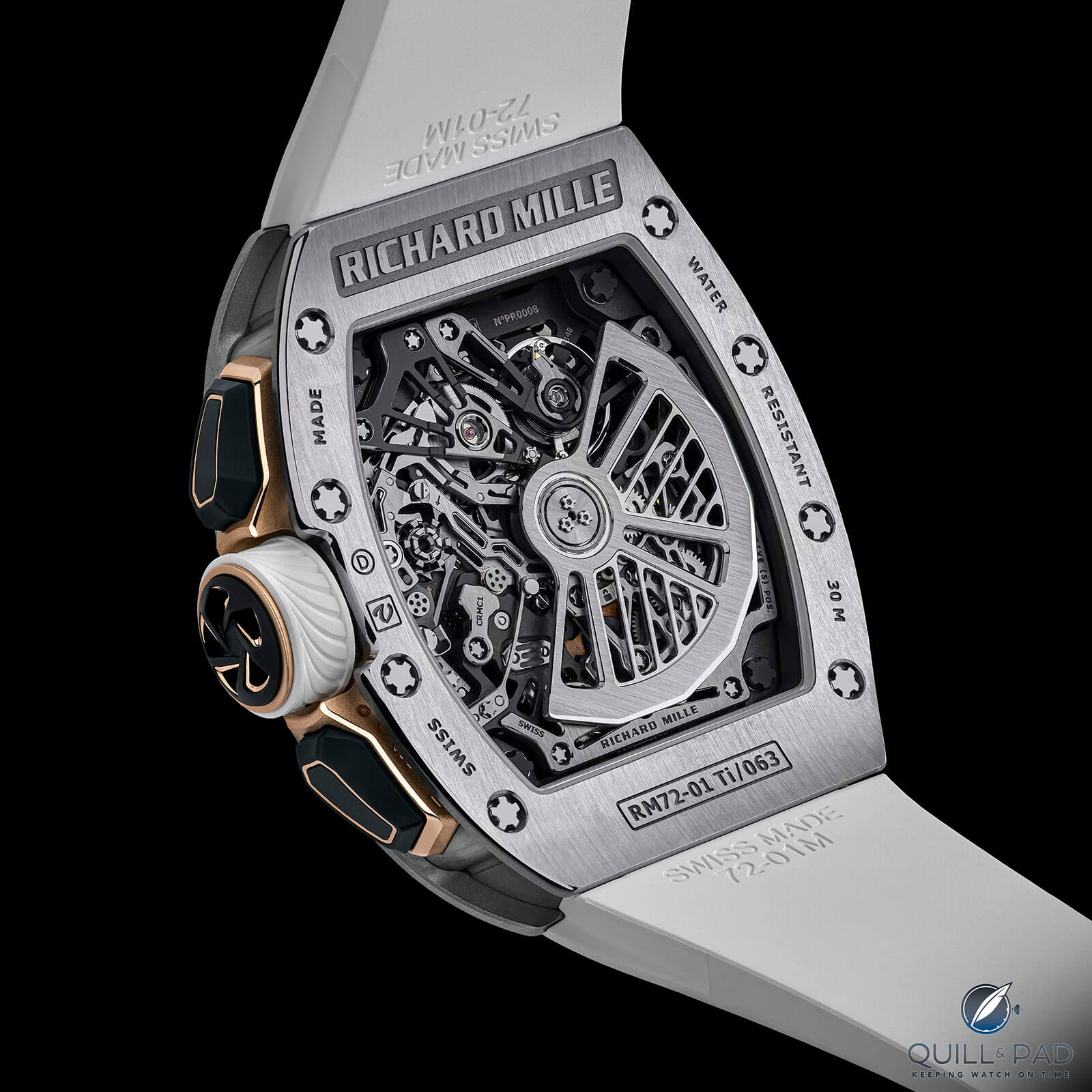
Back of the Richard Mille RM 72-01 Lifestyle In-House Chronograph
Richard Mille’s standard chronograph, the dynamic RM 011, was powered by a bespoke Vaucher movement with a Dubois Dépraz module for the large date and annual calendar. A curious aside is that the fresh, new RM 72-01 Lifestyle In-House Chronograph comes in at about the same price – and while the price is very likely far beyond the means of the average watch buyer, for Richard Mille’s clientele the in-house movement at the same price is likely to be a big plus.
The most interesting thing about this new chronograph, though, apart from its modern, skeletonized movement and funky-fresh design, is its new technology, the result of about 30 months’ worth of full-time research and development.
With its two-pusher system, the RM 72-01 chronograph looks pretty standard from the outside. But the freshness begins with these pushers: they are attached to double-toothed levers calibrated to require the same push force whether starting, stopping, resetting, or even – as this is a flyback chronograph – returning to zero.
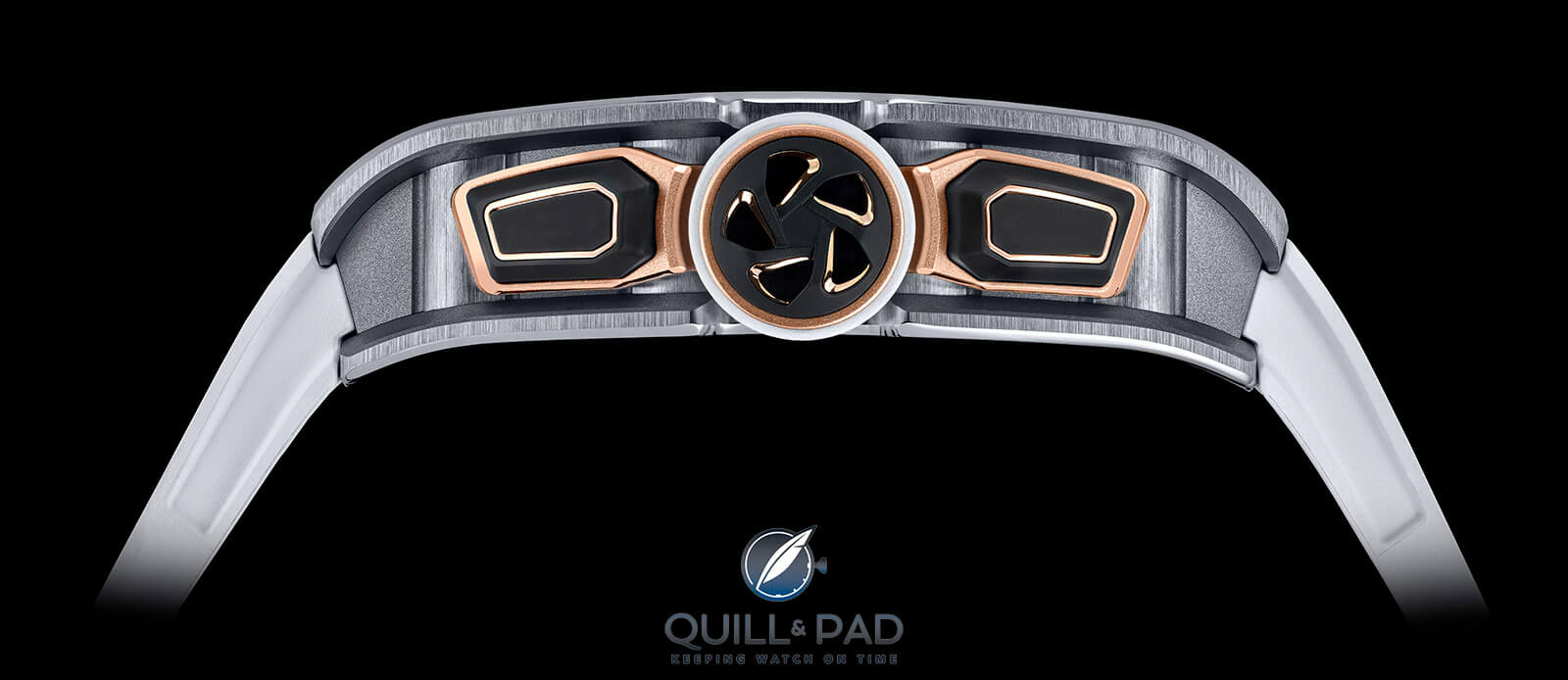
The substantial pushers and crown on the case band of the titanium Richard Mille RM 72-01 Lifestyle In-House Chronograph
The pushers’ pressure was precisely calculated by the engineering team so that the feel always remains gentle yet determined. The shape and surface of the pushers are very conducive to pushing and the click audible and pleasant, all of which I can personally attest to after spending some time with this stunning chronograph.
Richard Mille chronograph Caliber CRMC1: torque transfer and maintaining the same power reserve
Richard Mille’s technical director for movements, Salvador Arbona, explained that his team started with the in-house automatic caliber’s barrel, going train and regulator, after which they suspended torque transfer with the goal of separating the chronograph functions from the hour-and-minute display. This is a new achievement in watchmaking, and it was accomplished with a specific goal in mind: not having these two functionalities feeding from the same energy source.
This means that the RM 72-01 Lifestyle In-House Chronograph’s power reserve is always 50 hours, regardless of whether the chronograph is running or not. That is a big deal, especially for those who actually use their chronographs rather than just admire them.
The RM 72-01 differs from traditional chronographs in looks, but also – importantly – in mechanics. In a standard chronograph, the movement’s fourth wheel normally feeds the chronograph; that does not happen here.
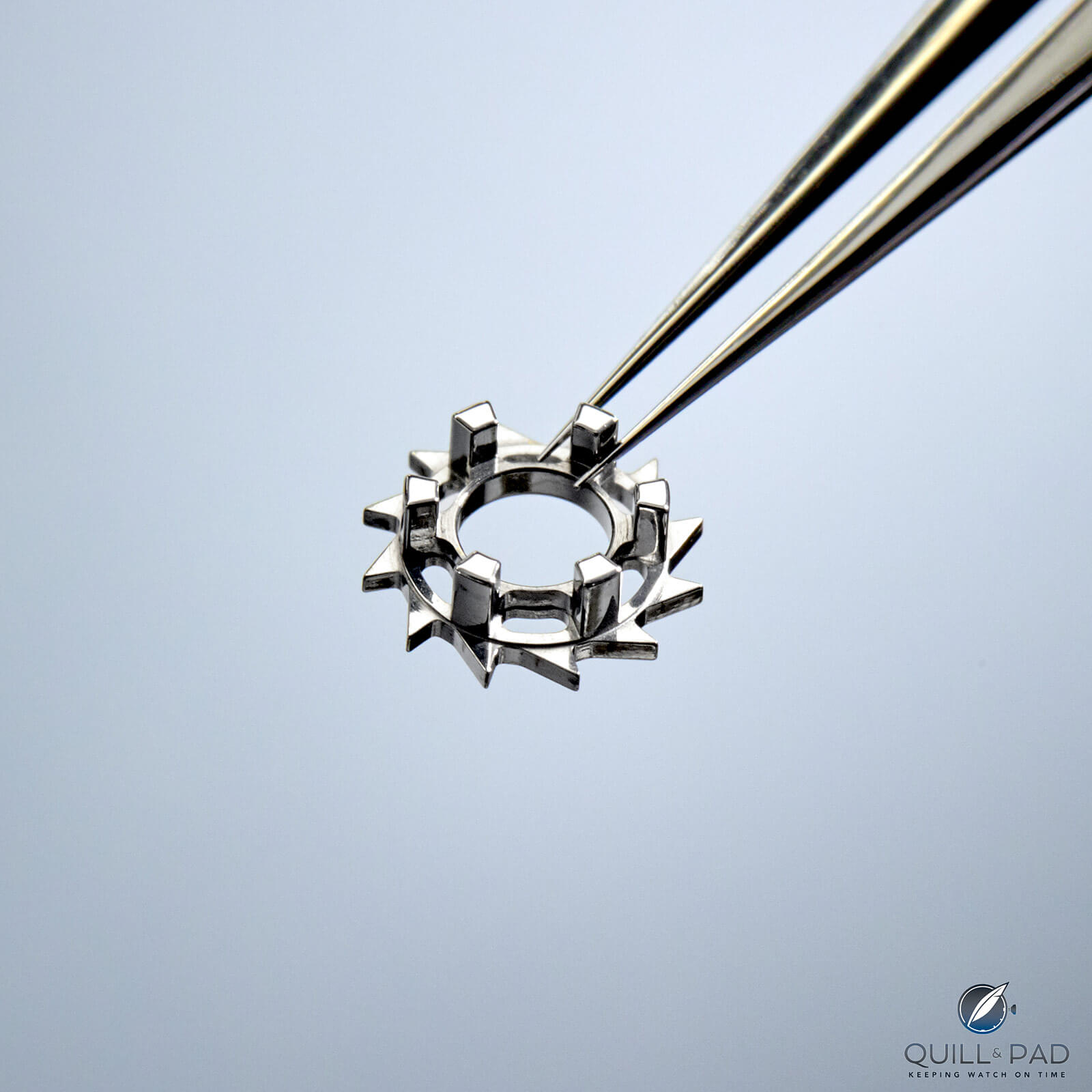
The six-column wheel controlling the chronograph in the movement of the Richard Mille RM 72-01 Lifestyle In-House Chronograph (photo courtesy Richard Mille/Jerome Bryon)
“We separated the hours from the rest of the piece and also the minutes from the seconds,” Arbona explained in a statement. “Independent from each other, the three time scales are coordinated by one wheel with six columns. We also completely separated the chronograph’s torque from the minute and hour display.”
In other words, the counters are separate from each other rather than being linked. And the time is separate from the chronograph. Which is also why the power reserve always remains the same – there is no power drain in sharp contrast to a “normal” clutch chronograph, whose power comes down from the fourth wheel.
The only real disadvantage I have ever noticed with the standard chronograph system is the drain on the movement’s energy when the chronograph is in use, though that is not usually a concern in an automatic watch except for heavy users. However, I’m guessing it was a point of pride for Richard Mille to develop something new in chronograph technology.
The next question, of course, is how did the team do it? The answer is that this new clutch system is fitted with double oscillating pinions, a first in the industry and patented by Richard Mille.
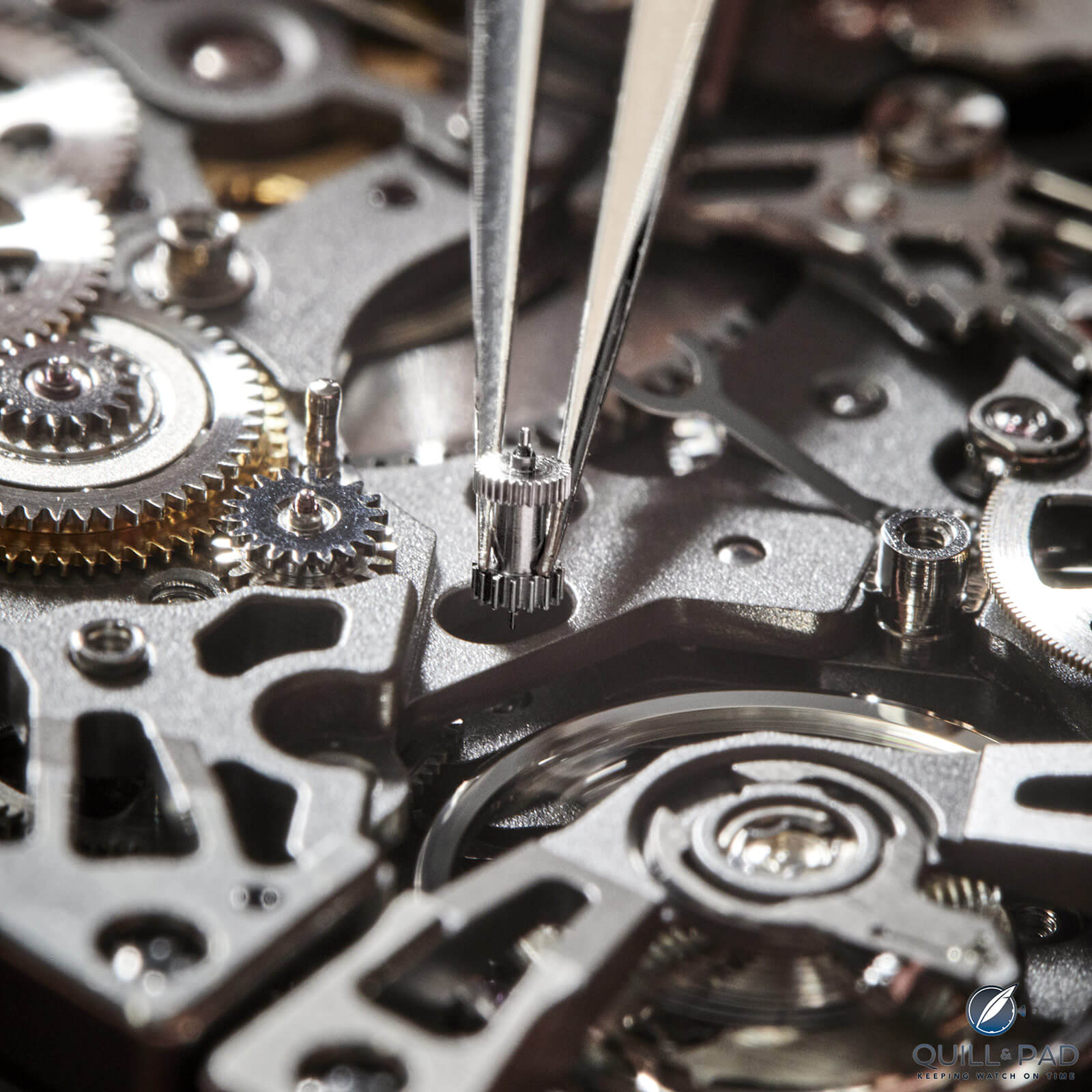
Inserting an oscillating pinion into the movement of the Richard Mille RM 72-01 Lifestyle In-House Chronograph (photo courtesy Richard Mille/Jerome Bryon)
“This little pinion that goes in or out of the teeth has been doubled,” Arbona continued. “There is one for minutes and another for seconds. The system is less bulky compared to a vertical coupling, which is difficult to fit in the middle of the movement.”
In this system, where torque is split by the two pinions, it is also uninterrupted and constant. Compare that to a traditional chronograph, where the fourth wheel feeds into the third wheel every 60 seconds using meshing gears, which, according to Arbona, creates a jolt.
In Richard Mille’s new system, the seconds and minutes are each driven by their own oscillating pinions; torque transfer is kept to a minimum and remains constant for as long as the chronograph continues to run.
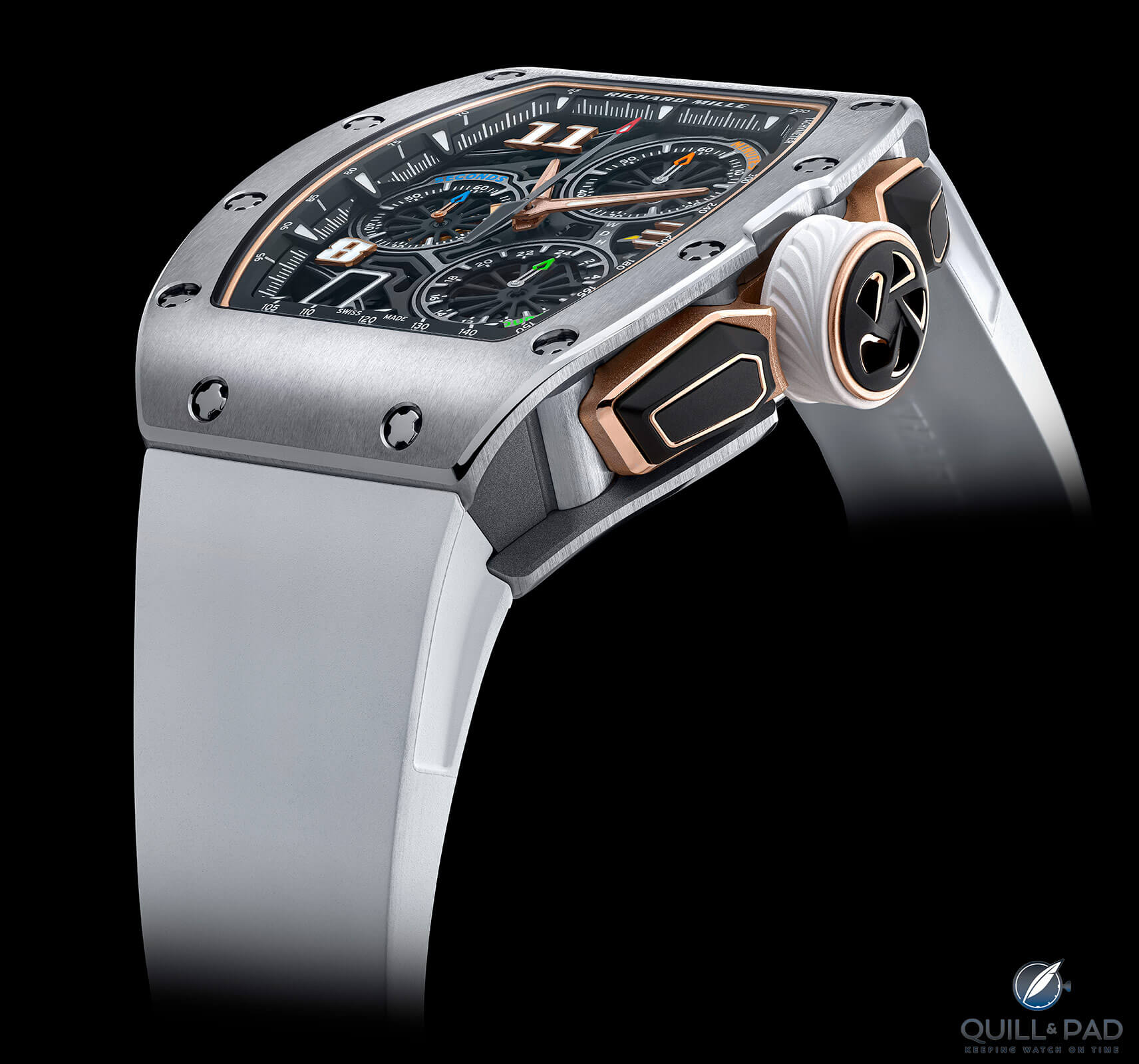
Richard Mille RM 72-01 Lifestyle In-House Chronograph in titanium
Also unusual is that the minute totalizer can tally up to an hour, while the hour counter totalizes up to 24 hours. Those are pretty long totalizers – even able to time the 24 Hours of Le Mans!
Richard Mille Caliber CRMC1: other notable features
Richard Mille watches have included function selectors almost right from the beginning – an original invention of APRP – which are built into the crown, and this functionality has carried over into the brand’s in-house chronograph movement. By pulling out the red gold and TZP ceramic crown you can choose between winding (W), date adjustment (D), and time setting (H). No need to fiddle with pulling the crown out just the right amount.
One other fun function reinterpreting a beloved element of previous Richard Mille watches is the vertical date display, which is not exactly new – it was prominent on the RM 67-01 of 2016, for example, which also included a function indicator. That watch was an extra-flat automatic, so saving space with this configuration made a lot of sense. The date on the 67-01 is at 5 o’clock, and on the 72-01 it is across the dial at 7 o’clock.
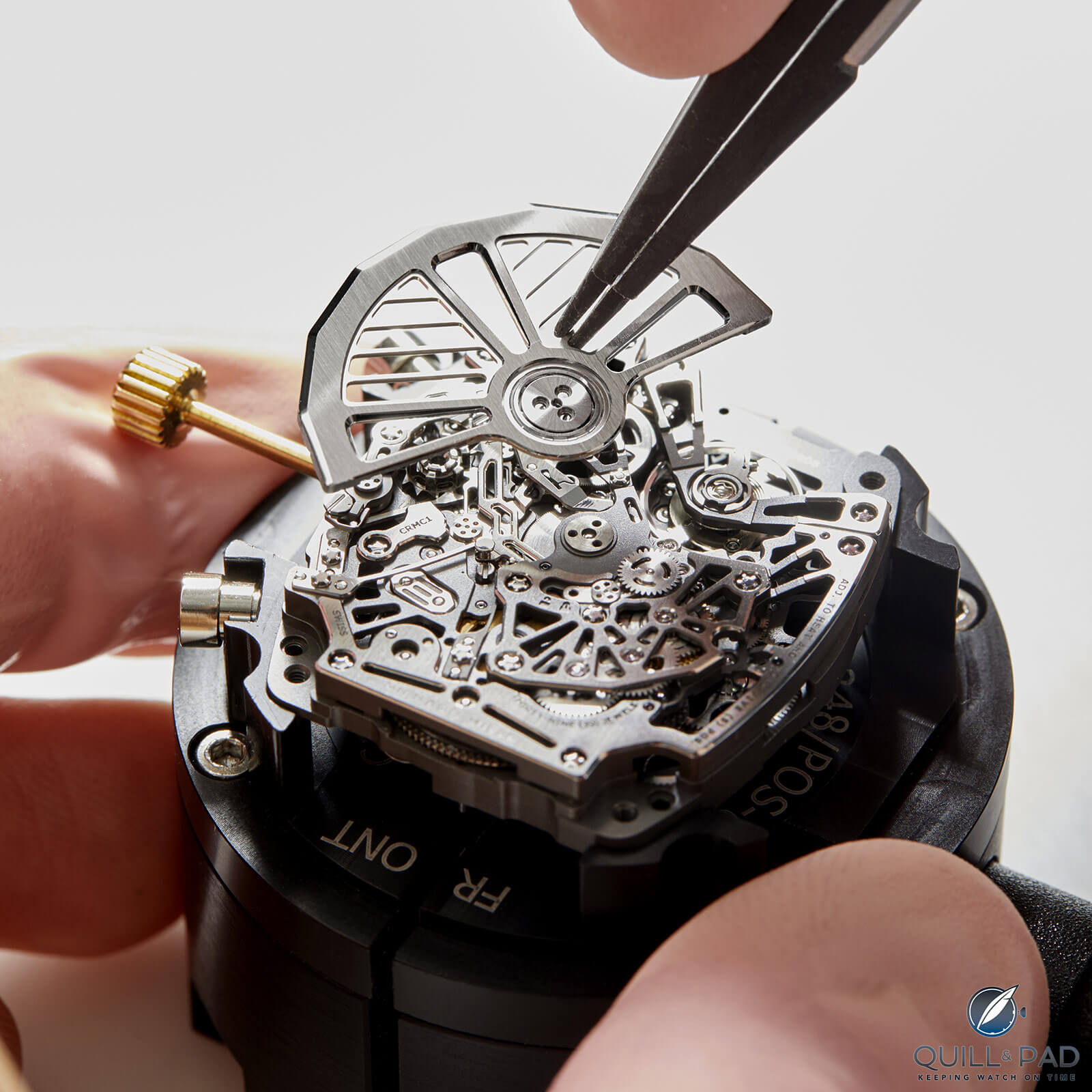
Adding the one-piece rotor to the movement of the Richard Mille RM 72-01 Lifestyle In-House Chronograph (photo courtesy Richard Mille/Jerome Bryon)
The automatic movement’s platinum rotor is crafted from a single block to save on height – which is why Arbona and his team didn’t use their normal variable inertia geometry rotor. The high density of platinum maximizes the winding power, while the ball-borne reversers optimize bidirectional winding efficiency. Despite its 425 components, Caliber CRMC1 is slim, only 6.05 mm in height.
The RM 72-01 is available in four case variations: 5N red gold, titanium, white ATZ ceramic, and black TZP ceramic. The substantial and easy-to-use crown on all variations are made of red gold and TZP ceramic.
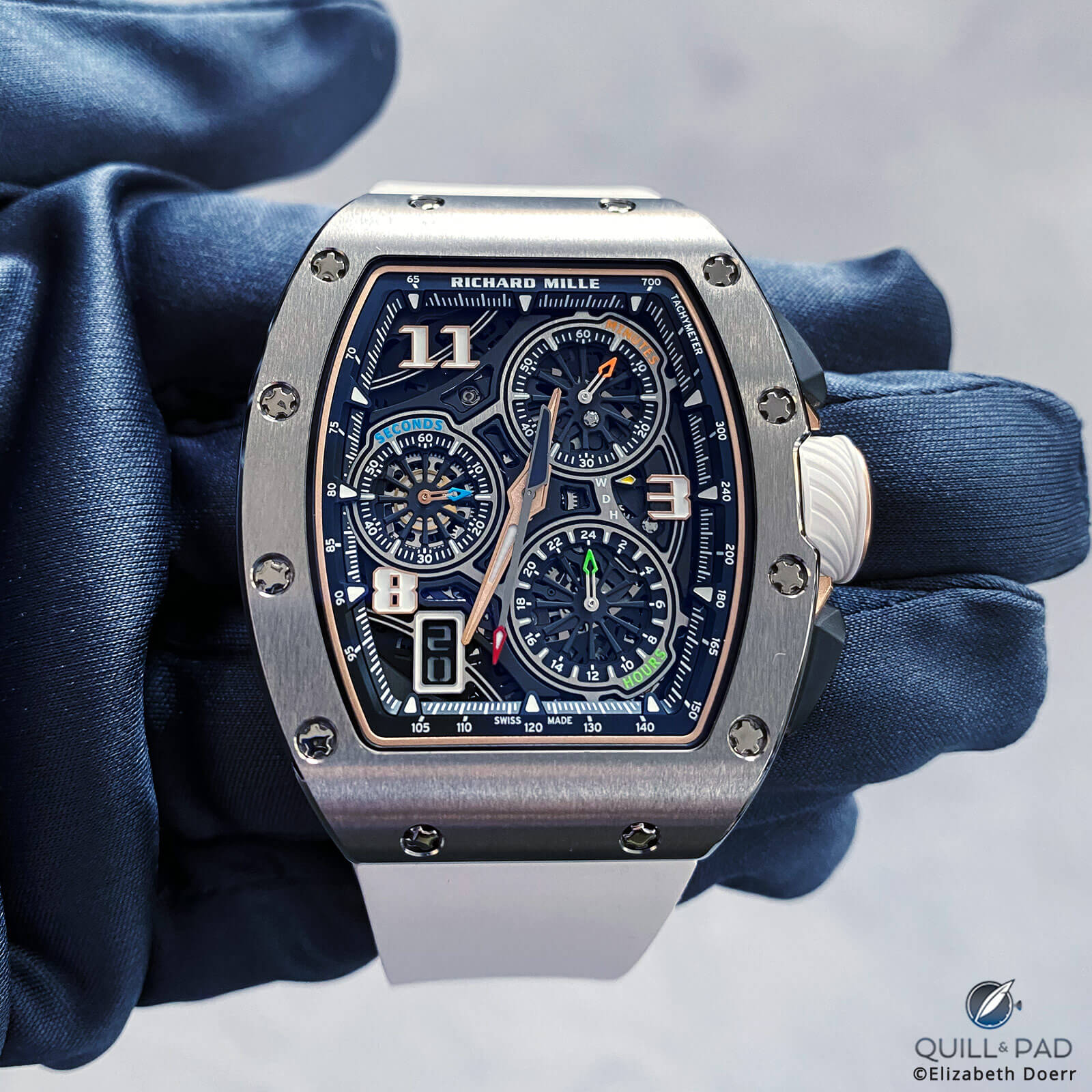
Richard Mille RM 72-01 Lifestyle In-House Chronograph in titanium
All of this effort was well worth it: the new RM 72-01 comes in at 11.68 mm in height, making it wearable for even those with small wrists. To compare, the previous RM 011 iterations were more than 16 mm in height. And while the RM 011 was rather comfortable, even on my small wrist, because of its well-thought-out design, I can attest that the slimmer case is even more comfortable.
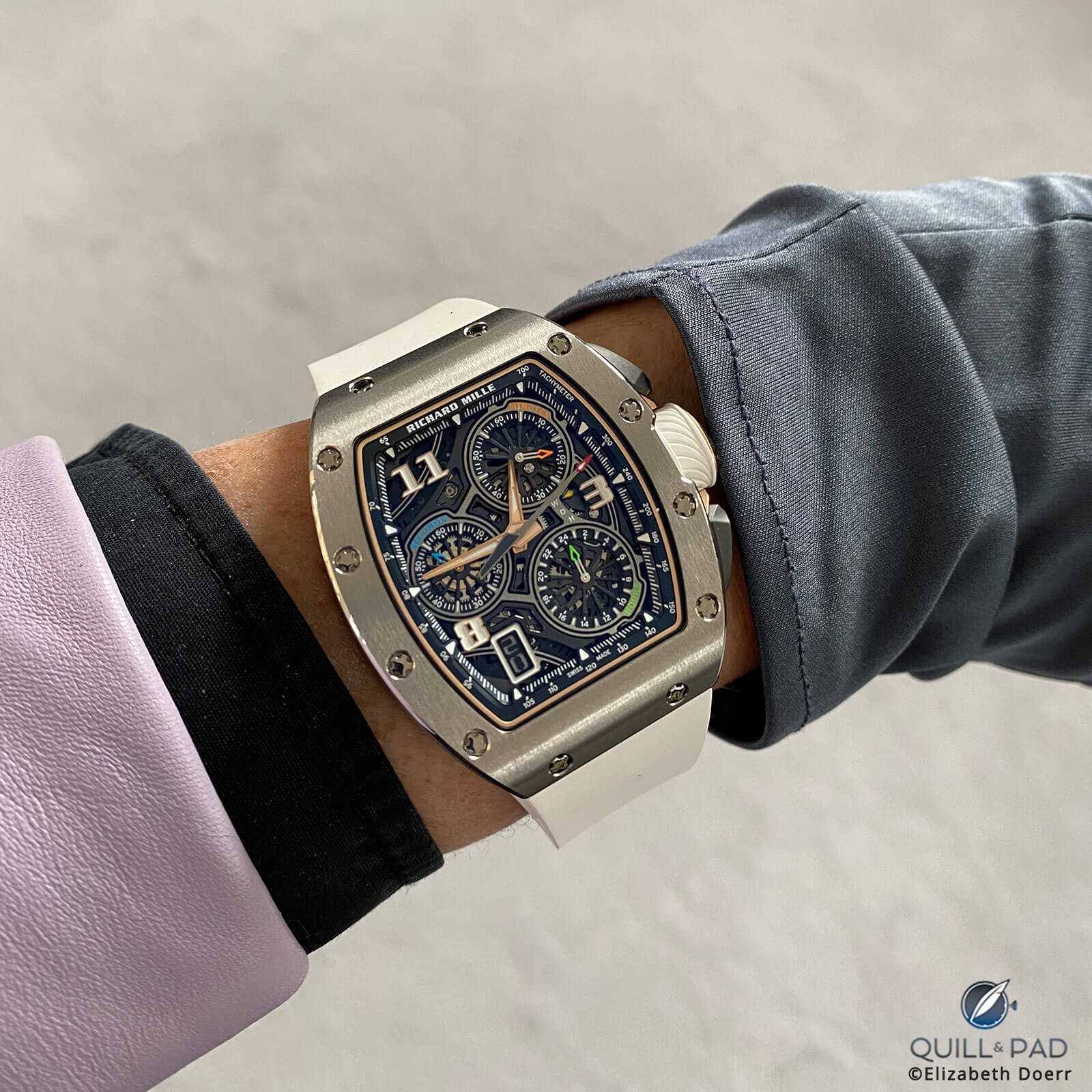
Richard Mille RM 72-01 Lifestyle In-House Chronograph in titanium on the author’s wrist
For more information, please visit www.richardmille.com/collections/rm-72-01-automatic-flyback-chronograph.
Quick Facts Richard Mille RM 72-01 Lifestyle In-House Chronograph
Case: 38.4 x 47.3 x 11.68 mm, red gold, titanium, white ATZ ceramic with red gold case band, or black TZP ceramic with red gold case band
Movement: automatic Caliber CRMC1 with platinum rotor and flyback chronograph with double oscillating pinions, base plate and bridges in titanium, free-sprung balance, fast-winding barrel, 6.05 mm in height, 50-hour power reserve, 425 components, 4 Hz/28,800 vph frequency
Functions: hours, minutes, (hacking) running seconds; date, flyback chronograph with central seconds, 60-minute and 24-hour totalizer subdials, function selector, tachymeter on flange
Price: beginning at $188,000/CHF 170,000 for titanium
You may also enjoy:
Richard Mille RM 53-01 Pablo Mac Donough: A Timepiece Warrior Persians Would Have Appreciated
Alexander Zverev’s Ultra-Light Richard Mille RM 67-02 Is Serving Aces
Richard Mille RM 62-01 Tourbillon Vibrating Alarm ACJ: You Can Feel It!
Richard Mille (All-Female) Racing Team And The (Virtual) 24 Hours Of Le Mans
Leave a Reply
Want to join the discussion?Feel free to contribute!





















































Like all Richard Mille watches, it is supremely ugly
Surprised so technical of a watch would settle for 30m water resistance.
I like RM case style and commitment to engineering but confess my plebeian nature and, like Panerai, all pretty much look the same to me.
30 m is truly more than enough for daily sporty activity and even for taking in the water. Any further water resistance would have increased the case height, which I believe the engineers were specifically looking to avoid.
What an incredible piece! The RM 72-01 not only showcases Richard Mille’s signature design but also the innovative fluid constant force chrono pushers. It’s fascinating how they’ve combined aesthetics with such advanced functionality. The video really highlights the craftsmanship involved. Thanks for sharing this detailed look!